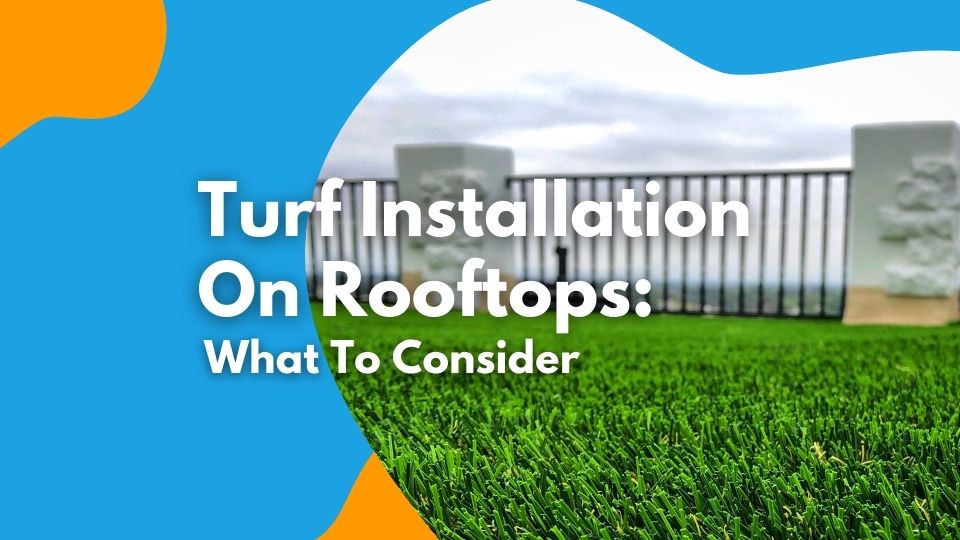
While putting artificial turf on a rooftop deck is a creative long-lasting way to enhance your space, it can come with costly repairs if not designed and installed...
A complete guide on how to install artificial grass on balconies, patios, rooftop decks, and other hard floor spaces. Determine if this is what you need. Learn about the differences between landscape and hard floor artificial grass installation. Find the right materials and approaches for balconies and rooftops. Prevent potential balcony artificial turf installation flaws.
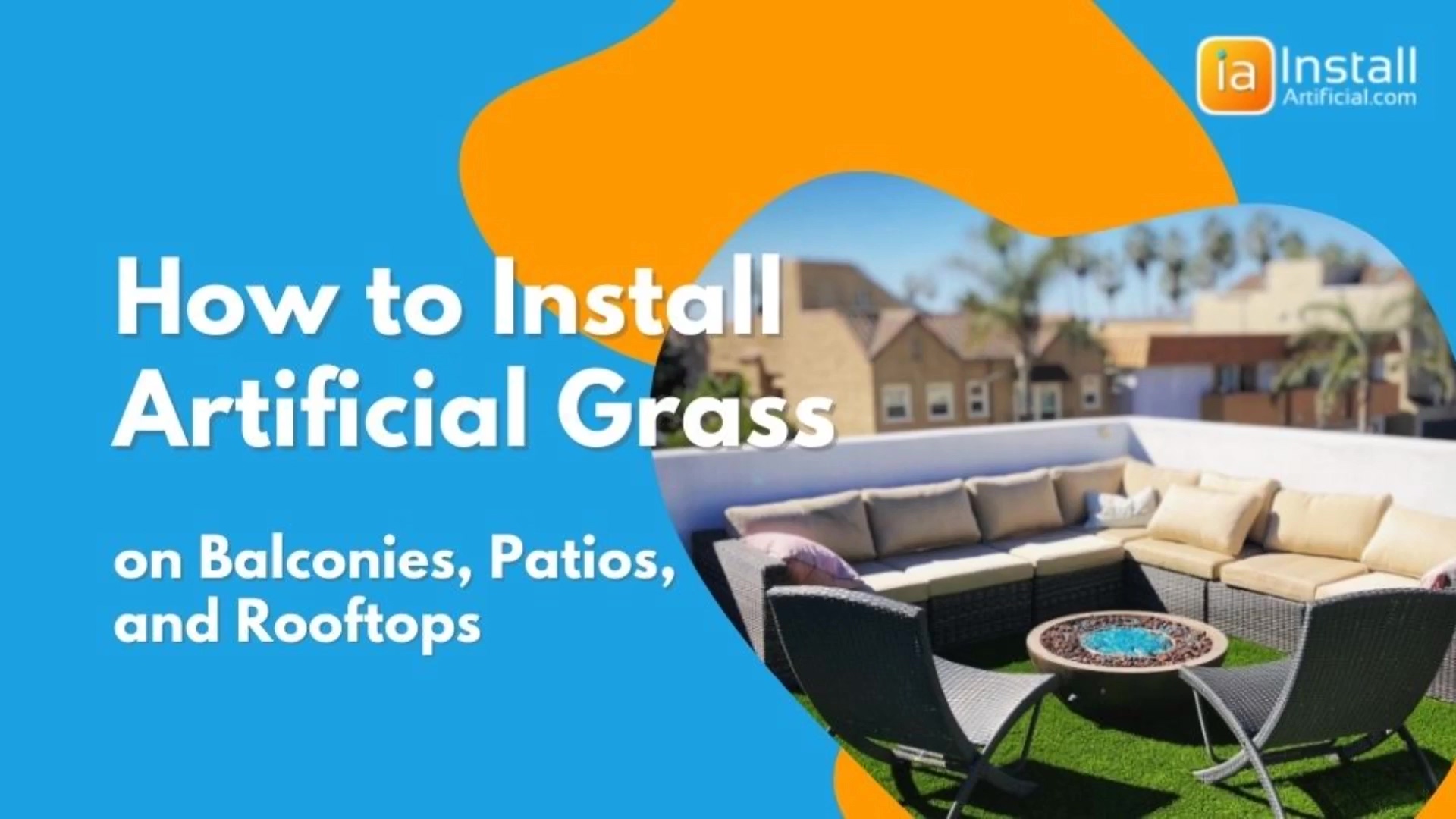
Frequently Asked Questions About Installing Artificial Turf Over Hard Surfaces
Artificial grass has many benefits and is common on balconies because it's soft, barefoot-friendly, and spruces up the look of your space. Turf doesn't have the same care needs as natural grass, so you can install it in many places including balconies and patios.
With artificial turf, you can create an artificial lawn on any surface to enhance outdoor spaces, including wooden decking. Whether you have a large balcony or a small balcony, fake grass can transform your space. Below are just a few of the many reasons people opt for the installation of artificial grass on balconies, rooftops, and patios!
The most obvious reason people are installing artificial turf on a balcony or patio terrace is to make your space more cosmetically pleasing. Balcony turf adds more functionality to your most unusable areas. Adding artificial turf to your outdoor areas also improves property value. You can create almost any space you want because the grass can be cut and placed around any obstructions. This also gives you the option to only partially cover your area with artificial grass. The possibilities are endless. Your creativity can create the perfect space to entertain guests or simply have your morning coffee.
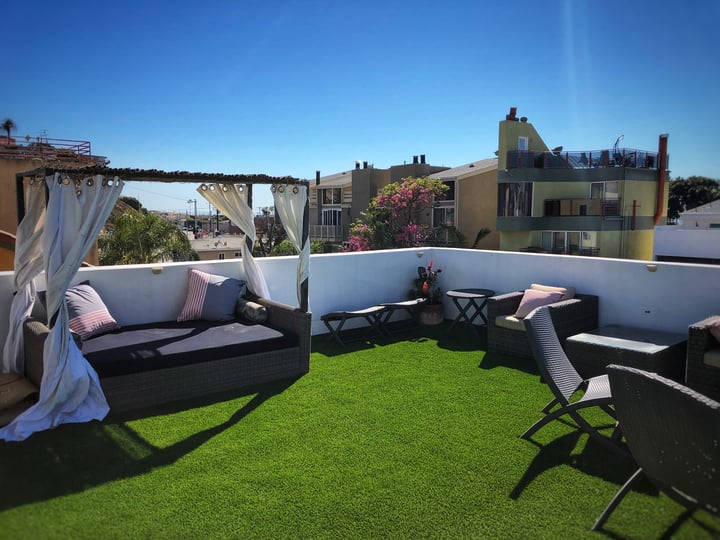
Installing synthetic grass on your balconies, rooftop decks, and patios terraces also brings a softer and safer surface. Concrete and wood surfaces can become very slippery when wet and pose a dangerous risk. Laying down turf can help avoid mold and mildew growth on your deck as well. Drain core is installed underneath the turf to alleviate the area of moisture quickly. It is a good drainage for balcony turf. Also, artificial grass is significantly less slippery than concrete or wood when wet.
Maintaining your freshly installed artificial turf is quick and simple. Because it's artificial, there is no need to keep it trimmed or watered like natural grass does. How nice does that sound? The turf can be cleaned like most indoor surfaces, it can even be vacuumed - yes you heard that right. For any unwanted leaves or foliage, you can simply pick them up by hand or use a rake to form a pile. For light spills or pet messes, we recommend using water and a cleaning solution to rinse the area. Don't worry, your drainage system will soak up the moisture.
To learn more about grass turf on balcony pros and cons, check out our article Benefits of Installing Turf in Unconventional Spaces!
Not all types of artificial turf are suitable for every surface. So what is the difference between grass used for lawns and grass used for patios? Because we try to eliminate the need for a sand infill, there are fewer options when it comes to installing artificial grass on a balcony, rooftop, or patio.
When deciding what grass is best, you want to look for an option that has good dimensional stability and thicker blades. Grass with a thicker thatch is less likely to wrinkle and buckle as temperatures rise. To make your space barefoot-friendly, opt for soft and plush artificial grass! Also, to avoid any drainage issues, ensure the artificial turf used is permeable with drainage holes punched throughout.
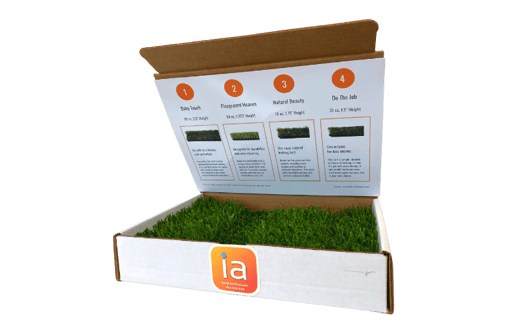
Because we want to eliminate sand infill, we recommend using thick thatch grass for better dimensional stability. This will be the best fake grass for a balcony. Thicker blades also work better for balconies, patios, and rooftops. As temperatures rise, you want a more heavyweight option that won't buckle as much and cause wrinkling.
This refers to the turf's ability to retain its original size. For these projects, we recommend a heavier material that doesn't expand and contract as much in the sun.
Nylon is a very strong material with the stiffest blades. It holds its shape under distress, and as mentioned earlier it is the only turf that withstands really high temperatures. Due to its strength and durability, it's the most expensive artificial grass material. However, because it's so tough it can lose the natural look and feel of real grass. This material is recommended for commercial rooftops, areas that receive a lot of direct sunlight, or spaces at risk of magnification.
There is a substantial difference between installing artificial turf in enclosed areas as opposed to open areas. When you have an open balcony, the installation process becomes more difficult. Over time wind may pick up the artificial turf causing the edges to flap, or even worse fly off the rooftop damaging property or injuring someone below. In this case, you have to make sure that you prevent the artificial turf from uplifting by either applying weight to the surface (with furniture) or attaching it to the roof.
Another way to prevent wind damage is by applying a heavy layer of sand infill to weigh down the surface. However, sand tends to make surfaces warmer and will eliminate the ability to vacuum your artificial grass.
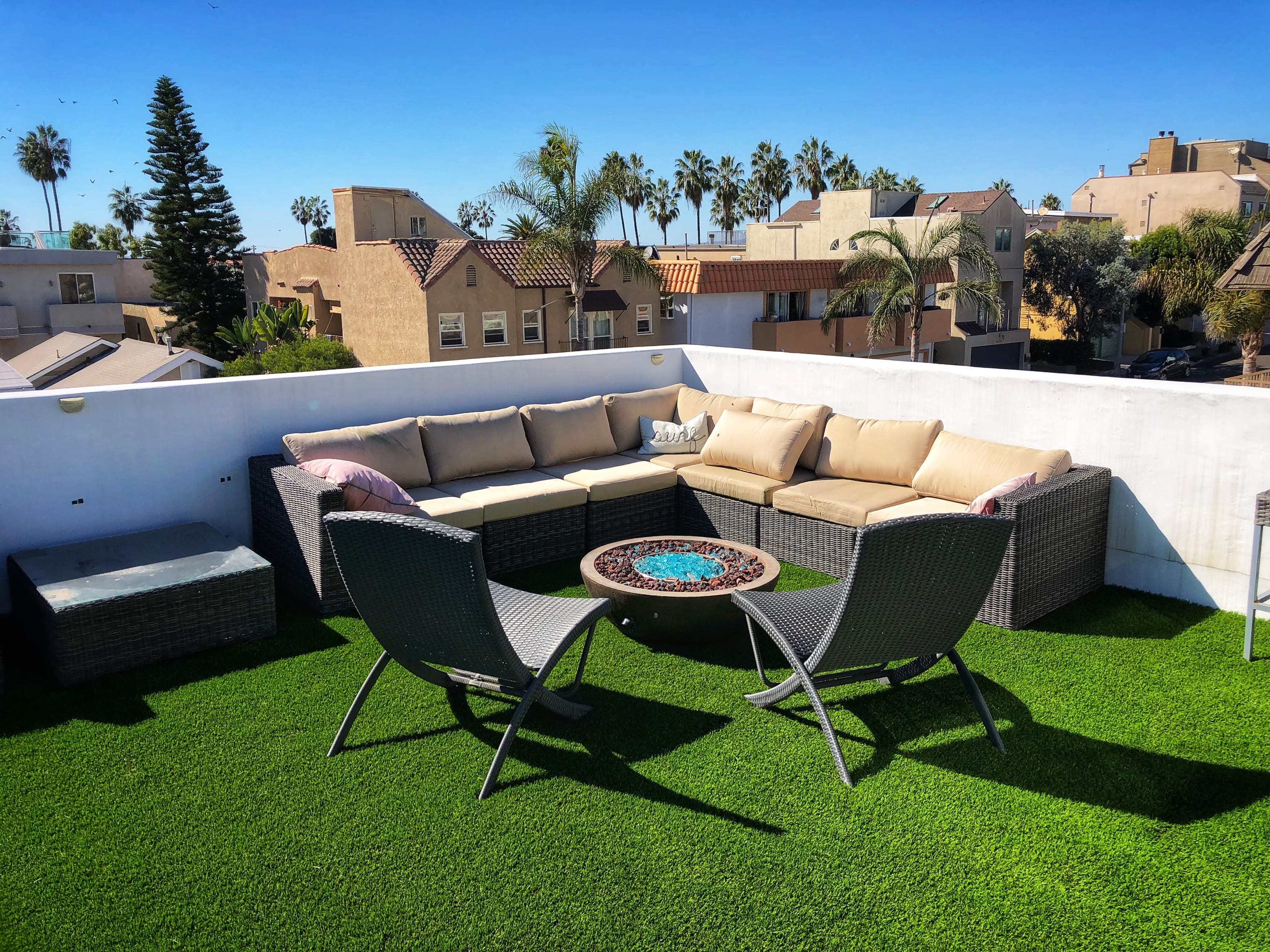
Magnification is a common issue with Artificial Grass. Like anything laying in direct sunlight, artificial grass can become warm on high-temperature days. Magnification happens when the sunlight is reflected from windows, multiplied, and then reflected onto the surface of your artificial grass. This can lead to turf melting. Most balconies will have another balcony directly above that can block the sun and prevent magnification issues. However, in some cases, there is an overhead window that reflects sun onto the surface causing magnification to occur.
Fortunately, most balconies are designed and constructed with water drainage in mind. We do not recommend installing artificial turf in any area that has an issue with water pooling. You don't want your artificial grass retaining water. If water builds up, mold and mildew can occur. Before you lay artificial grass, you'll want to confirm that there is somewhere for rainwater and other liquids to go. In most scenarios, a drainage grid should be installed underneath the turf to allow water to escape quickly.
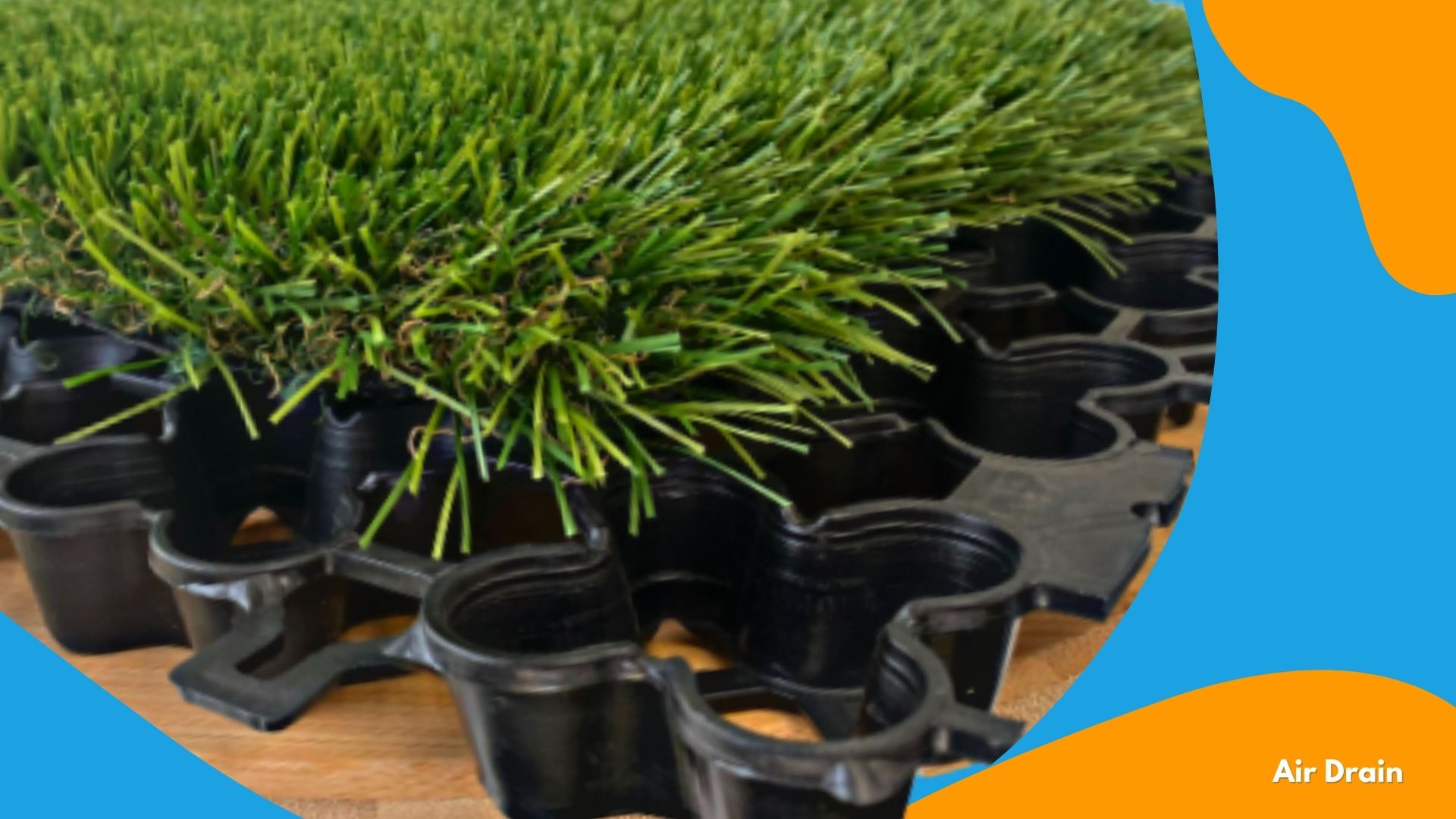
While door placement is not something people think to consider when deciding if artificial grass is the right decision, it can affect installation. Most balconies have sliding doors that don't open outward. While this is the best scenario, we know that not all balconies are the same. Doors that open out onto the balcony can have issues going over the artificial grass. If the door can't easily open and close after your turf installation this can quickly become a safety hazard.
In this situation, you can either trim the grass to allow the door to open, or install a piece of shorter turf in that area. To prevent any tripping hazards this piece would have to be glued to the surface. If you do have a door that opens out onto the balcony, there must be at least a gap of approximately 1 inch to allow enough space for turf placement.
Can you put furniture on artificial grass? Yes. Similar to placing furniture on carpet, as long as your furniture doesn't have any sharp edges or broken pieces it should not tear or damage your turf. One thing to keep in mind is that if your furniture is very heavy it will in time leave an imprint in your artificial grass. For any large pieces of furniture, we recommend moving them around every few months to prevent imprints from occurring. A thick and durable grass is best when planning to fill the space with furniture. Thicker turf will keep your furniture more level.
Artificial grass can be damaged by any hot embers or coals from fire pits and grills. It is not recommended to place these items on artificial grass. However, this can be easily avoided by installing turf in a smaller area to utilize the grassy space while still enjoying those amenities.
Also, remember that stainless steel appliances, such as grills, can burn your artificial grass or even plastic tiles. We recommend installing wood tiles around grills. Wooden floor tiles do not melt and are much easier to clean when food or grease falls from them.
There are several options for the drainage system. Before making a decision, it's important to diagnose which option will work best for you and your space.
Artificial grass sits on stitches and has holes every few inches in every direction. While this is not the best ventilation, water will eventually evaporate when turf is placed in open areas under direct sun. However, the turf will hold water runoff, which will lead to the growth of bacteria, so a layer of drainage is recommended.
The drain core cell is a flexible material. It allows grass to sit on bumps and breath efficiently. The water will run off the roof quickly. While it is the most affordable drain grid, when walked on it produces a cracking noise when installed over rough surfaces. This can also expand under direct sunlight causing wrinkles. (when not glued down).
This is a rigid 1-inch tall material. It provides the best ventilation and fastest runoff. It expands moderately in the heat and doesn't show waves or inconsistencies. The shortcoming of this material is that heels may puncture the grass not only damaging the turf but can result in injury. Heels should not be worn on this surface.
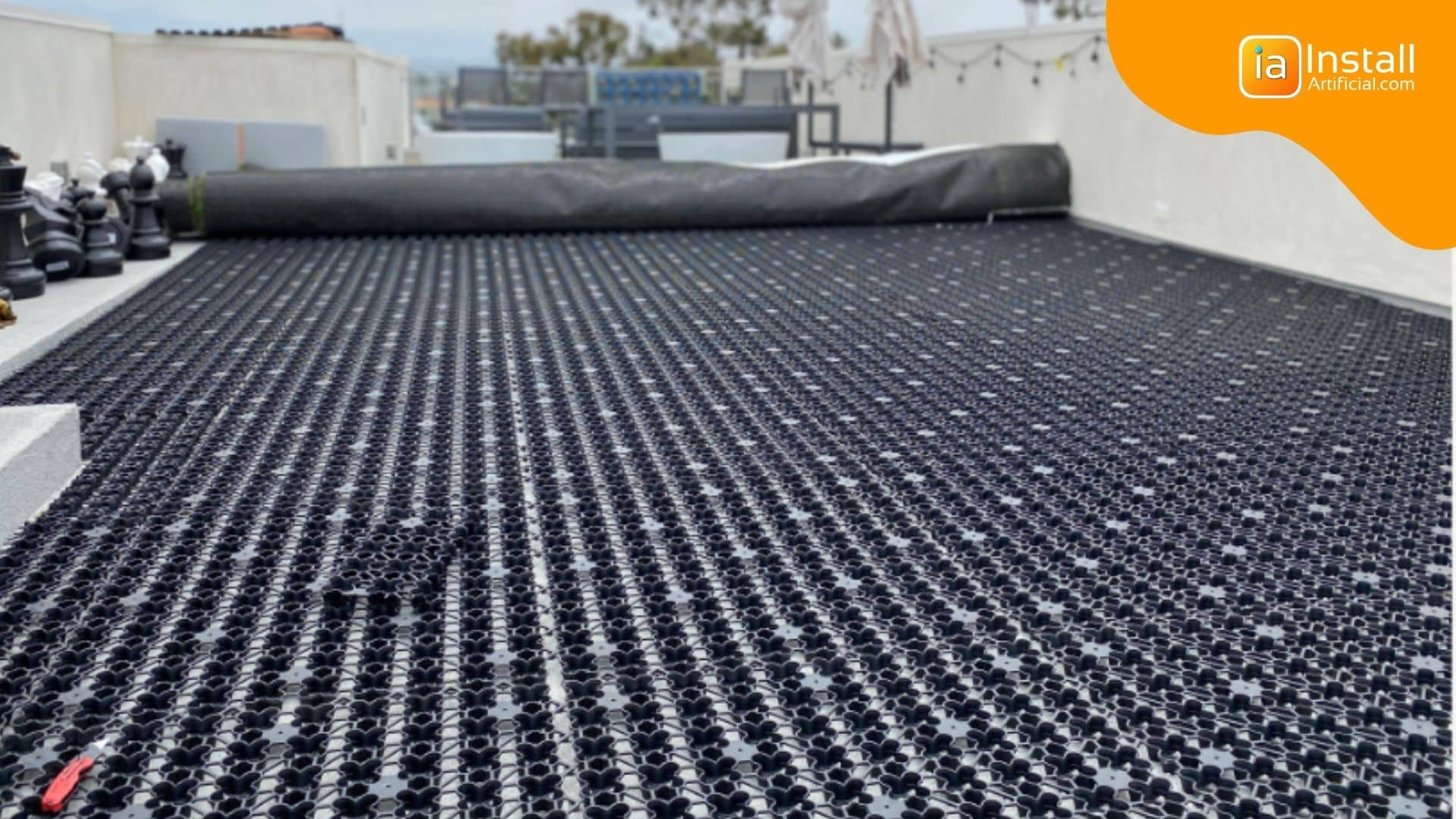
This rigid and small celled tile is very durable. It is best for event areas. It will survive heels and heavy furniture. Turf is also able to be glued directly to the tile.
Perfect for kids and low flow drainage. This option is often used in enclosed areas as it improves risks of uplift or must be glued down to the floor.
Without proper drainage, the longevity of your artificial installation will be greatly affected by the build-up of contaminants. Ignoring drainage can be a costly repair because flooding can easily happen. Once flooding on your balcony begins it can easily run into the interior of your home.
Check out our Drainage Options article for more info!
While the idea of being able to let your dog do its business right out on your balcony or rooftop sounds convenient, is it safe and sanitary? The answer is no. There are pet turf systems available for front and backyards, but it is not viable to allow dogs to pee directly on balconies and decks without a grass potty for dogs.
Without something to catch the waste, all of your pet's urine will accumulate under the fake turf and it will begin to smell and become unusable. There will also be bacteria growth over time. Even with a drainage layer, it's unsanitary to water down the turf and allow the waste to spill onto other people's property or your own walls.
An artificial turf porch potty is the best solution. Put a removable 1-inch tall container underneath the air drain cell and incorporate it into an area that your dog already uses often for relief. These containers are available in many sizes and forms.
Place the container under the turf and cut the drainage layer and turf in that area so it's removable when the container needs to be emptied and cleaned. The grass patch will be fastened with velcro tape for easy access. This makes the perfect patio/balcony potty for pets!
Even though having dog turf on a balcony requires maintenance, it is better than spilling dirty pet waste onto your neighbor's areas. Be a good neighbor! Use an artificial grass porch potty!
When installing artificial grass on rooftops there are a few extra things to keep in mind. The first is the current state of your roof. If the roof is in any way damaged we do not recommend applying artificial grass on top of it. The turf itself doesn't provide insulation and therefore won't provide any added protection. If at any point after installation there are leaks coming from the roof it becomes significantly harder to pinpoint where the leak is coming from and can become a lot more costly. For this reason, you should not install artificial turf directly to the base of the roof so that it can be removable when the roof needs inspection.
To hear more suggestions about what to consider before installing turf on a rooftop, check out our other article!
Installing a frame around the perimeter allows us to attach the artificial grass to the frame, rather than directly to the ground. This is beneficial because it makes getting underneath it easier in the event that repairs need to be made. It is much more cost effective to repair a damaged frame than the surface of your balcony, patio, or rooftop.
The most popular method to add artificial grass to a balcony or patio is to just simply roll it out and lay it down. While this sounds nice and easy, it typically won't achieve the desired look and feel. With no adhesive, the artificial grass may begin to buckle and wrinkle along the surface, posing a safety risk as well. Another risk in the laydown method is that your artificial turf can uplift and fly away any time the wind blows...Uh oh. Protect you and your neighbors and secure your turf!
In this method, artificial turf is glued directly to a base surface. We don't recommend this method. Gluing down directly to the surface will allow pockets of air to form and bacteria will grow. This also allows bugs and water to get into these pockets causing your synthetic grass to basically fall apart. It will also be very difficult to remove and can potentially damage the base it was glued to. Apply this method at your own risk.
There are a couple of ways to protect your turf from being pulled up by the wind. The most effective way is to use the frame method we went over above. This will make sure your turf is securely attached to prevent buckling on the edges. Another option is to put a heavy layer of infill down on top of the installed artificial grass. While this also helps prevent any uplifting, it restrains your options when cleaning your turf because it eliminates the ability to use a vacuum.
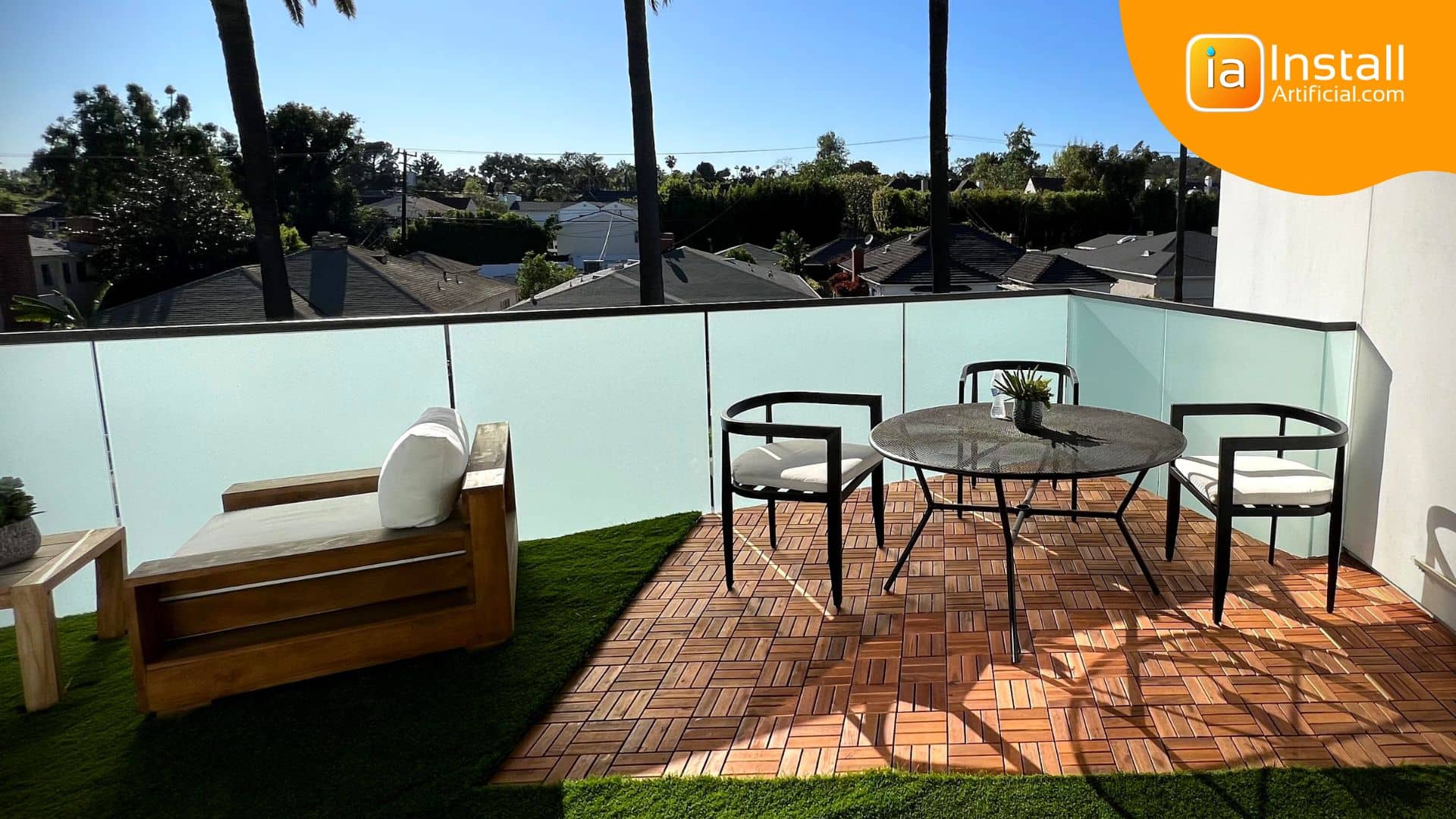
The great thing about installing artificial grass is that you can cut it to fit any area. You have control over how much of the space is covered with turf. To have a multifunctional area, you can combine fake grass with other surfaces.
If you prefer not to rely on furniture to keep your turf in place, you have the option to anchor it to your surface. Follow the steps below to securely anchor your artificial grass and ensure its stability on your balcony or patio.
Installing turf on wood surfaces, such as floors and decks, is a popular choice for many people. Anchoring your artificial grass to wood is not only possible but also easier compared to anchoring it to soil. It provides an added advantage for those opting for this installation method.
Tools Needed:
Preparing the Surface
The key to securely anchoring your artificial grass to a wooden surface lies in the thorough cleaning process. Make use of a deck cleaner and a scrub brush to eliminate any traces of grease, dirt, mildew, or pollen from the wood. After scrubbing, ensure that the cleaning solution is rinsed off completely, and allow the surface to dry completely before beginning the installation process. We recommend waiting at least 48 hours before starting the installation.
Once the surface is clean and dry, measure the amount of artificial grass roll you will need to cover the entire wooden area. Carefully roll out the turf pieces, positioning them as desired and ensuring that the grass fibers all face the same direction. Mark the base where two strips of turf join, as this will indicate where you should apply the glue. Finally, trim the perimeter of the grass to fit perfectly within your space. If you choose to add a layer of drainage to the surface for quick water movement, lay this down prior to unrolling the artificial grass.
Attach the Turf
Gently peel back the first piece of turf, revealing the smooth surface underneath. With precision and care, apply a thin layer of adhesive to the perimeter of each piece of turf, ensuring that every corner is covered. As you join the pieces together, make sure to cut S-seams or zipper seams instead of straight lines, creating a seamless transition from one piece to the next. To secure the joins, apply seam tape and turf glue just as you would when installing artificial turf on soil. However, on wood surfaces, there is no need for nails.
Once the turf is securely glued to the wood surface, take a moment to appreciate the transformation. To ensure the turf stays in place, use a weighted lawn roller, applying gentle pressure to every inch of the surface. This will guarantee that the turf is firmly stuck down, leaving no room for movement. As tempting as it may be, refrain from walking on the surface for at least a day, allowing the glue to dry and set completely.
There are many reasons why you might consider attaching artificial grass to your concrete surface, and enhancing the beauty of your space is definitely at the top of the list. If your concrete has started to show signs of wear and tear, such as being worn, chipped, or cracked, installing artificial turf can be a cost-effective way to give it a fresh and updated look. Additionally, artificial grass offers a safe alternative to concrete, thanks to its anti-slip surface. To ensure a successful installation, make sure you have the following tools and materials on hand.
Tools Needed:
Preparing the Surface
When it comes to installing artificial grass over a concrete surface, the first step is to thoroughly clean the concrete. You can opt for a cleaner specifically designed for concrete surfaces. Use a power broom or a push broom to effectively scrub away any stains, mold, or debris from the surface.
It's crucial to pay attention to the drainage on the concrete. If you notice puddling or pooling, drilling drainage holes may be necessary to ensure proper water flow. Fill any gaps with 10 mm shingle to prevent water accumulation. Additionally, if there are any uneven surfaces or small cracks, using a self-leveling compound can provide a smooth and even base for the artificial grass installation.
Anchor the Artificial Grass
Next, carefully trim the artificial grass to fit your desired size, ensuring that you cut from the underside for a precise and seamless finish. To securely join the turf pieces together, utilize seam tape and turf glue, just as you would if you were working with a wooden surface. Additionally, apply glue along the perimeter of each grass piece to firmly hold them in place.
Artificial grass is an amazing addition to any home or commercial space. It makes even the most unusable space livable. However, if not installed and maintained correctly you can run into many costly issues. When considering installing artificial grass there are a few main precautions to take to maintain the integrity of your installation.
The best way to prevent water damage is to make sure a proper drainage system is installed. You want to make sure there is air circulation and water flow. With nowhere for the water to go, some of it will naturally evaporate over time but if there is heavy rainfall it can quickly lead to flooding into your home. Also, the same way you wouldn't leave a food spill on your kitchen counter, you shouldn't leave any spilled food or drink on your artificial grass. Regardless of whether the waste is left on natural grass, concrete, or artificial turf, mold will grow when combined with moisture. Regularly removing debris and cleaning up spills as they happen is critical to avoiding mold.
Sometimes we see artificial turf have issues with static electricity which can become very annoying. While it typically goes unnoticeable, there are ways to prevent this from happening. A tip to avoid static electricity is to place an iron under the surface nailed to the ground. This piece of metal will then become a conductor and absorb any electric charge. Copper is usually recommended in this situation. Another simple way to prevent static electricity is to just water your grass. Adding a fabric softener can also be useful.
In order to prevent wrinkles, we recommend installing a frame around the perimeter of the area where the artificial grass is being installed. The artificial grass will be stretched and stapled to the frame. Another option is applying a layer of sand infill on the surface of your newly installed grass. Remember though, that applying sand will eliminate the ability to vacuum your surface.
Because there is no soil to remove from your base, it is an easier process to install artificial grass on a balcony or patio. DIY artificial grass on a balcony can become nasty quickly if you don't follow the correct steps. Check out our DIY Turf Installation article to learn how to lay your own turf on a balcony or rooftop. Or, here's what to expect during installation:
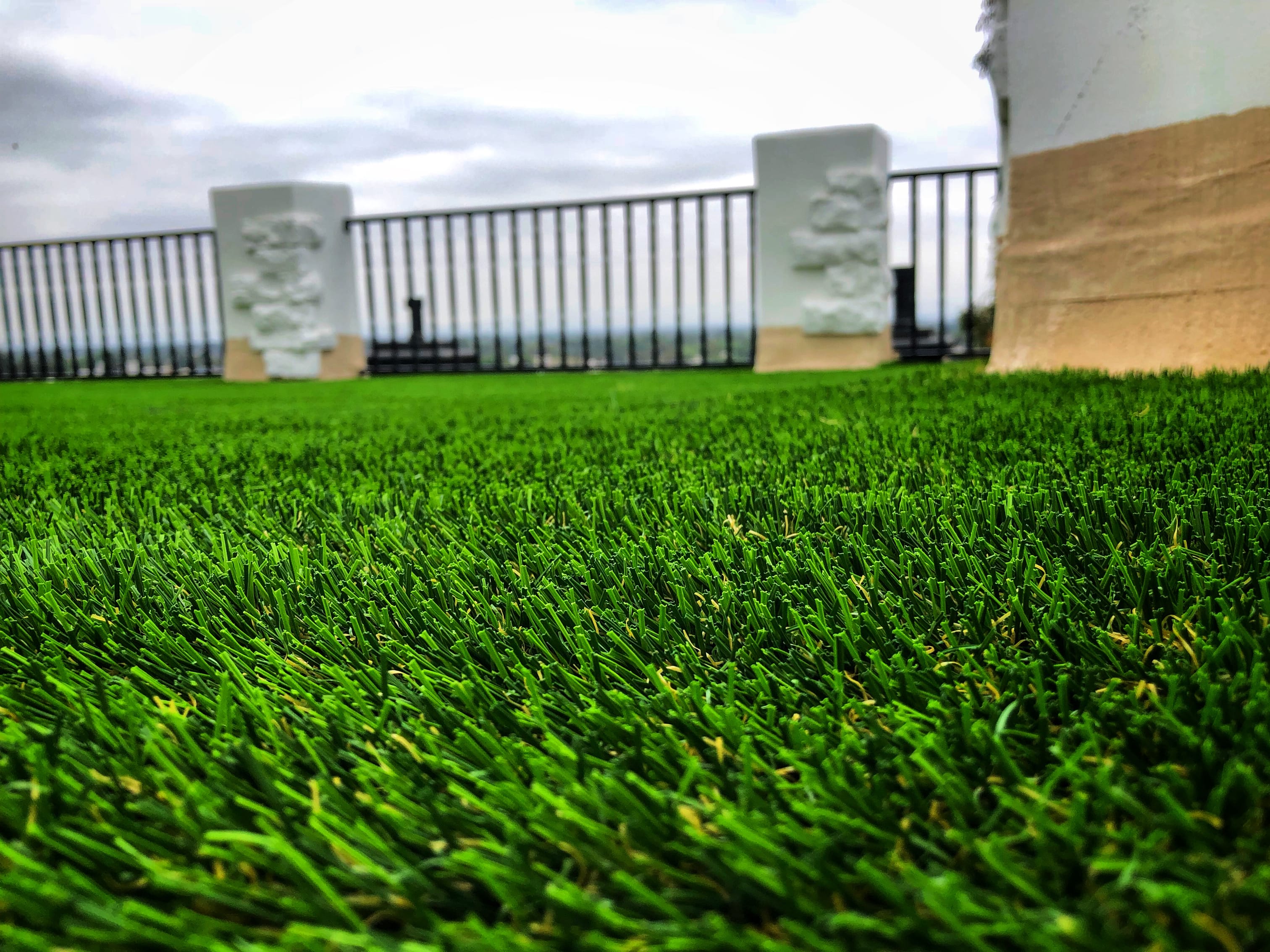
There are only a few types of grass that are compatible with balcony projects because you won't be using infill for most installations. When buying artificial grass, look for a soft and heavy artificial turf with improved dimensional stability and antimicrobial technology. This is usually your best option.
Oftentimes people don't purchase enough artificial grass. When determining the amount of turf needed, make sure to use measurements from the widest points of your space. Artificial grass comes in rolls that are 15 ft. wide so often you'll have to purchase more than needed and cut to size, make sure you factor that into your budget.
In some cases, it may be necessary to cut the grass before bringing it to the residence because the rolls may not fit through door frames.
You may be able to lift a lot, but in most cases, it takes at least 3 people to move large pieces of artificial grass. You will need 2 people to carry the grass while a third person navigates and watches the corners to prevent damage. Repairing any scratched or damaged areas is not a cost you want to add on. We recommend wrapping your rolls of grass to keep any sharp edges away from walls. Consider using a moving dolly, chiropractors also tend to be expensive.
You heard it right - there is no room for error. Once the grass is cut, it becomes very difficult to repair and patch small areas especially if you are not gluing.
We heavily recommend anyone installing artificial grass DIY in an area larger than 100 sq. ft. install a layer of air drain to the base prior to laying the fake grass. This will help prevent any costly issues and give your area an adequate water drainage system.
This part is crucial. Do your research when it comes to the glue you use. You want to use glue that doesn't expand and still secures the seams. Be very careful when applying the glue. If applied incorrectly glue can damage the surface beneath. Please also make sure you are not violating any HOA rules or guidelines when applying your adhesive.
You may have scraps left over that don't fit in your regular bins. Plan to haul away any excess material. We'd recommend holding onto any larger pieces to use in the event that the fake grass needs repaired or replaced in a certain area.
You've earned it! After putting in the time and money to enhance your space, it's yours to enjoy. You now have a barefoot-friendly area year round!
The best grass for rooftops is typically a type of artificial turf specifically designed for this purpose. Natural grass is not well-suited for rooftops due to the lack of soil depth, weight constraints, and the challenges of providing proper drainage and maintenance. Look for an artificial grass with durability, good drainage, and UV resistance.
People put artificial grass on their rooftop terraces for various reasons. The main reasons being for aesthetics and to create a green lush hang out space that is low maintenance and weather proof. Homeowners have also decided to install artificial grass on their rooftops for noise reduction and to use it as a outdoor recreation area.
When it comes to installing artificial grass on a balcony, there are both advantages and disadvantages to consider. While it can create a beautiful and low-maintenance outdoor space, there are a few drawbacks to be aware of. These include the initial cost of installation, the potential for heat retention on hot days, and the risk of mold or mildew growth if proper drainage is not in place. It's important to weigh these factors before deciding to install artificial grass on your balcony.
Artificial grass is not susceptible to water damage as it is designed to be water-resistant. In fact, high-quality artificial grass often features a permeable backing that allows water to easily pass through, making it an excellent choice for outdoor areas such as balconies.
Keeping your artificial turf on balconies in great condition is a breeze. With minimal effort compared to natural grass, maintenance is a breeze. If there is no infill, you can simply vacuum the surface to remove any debris. A stiff bristled broom can help re-fluff the blades. Additionally, spot cleaning with a sanitizer as needed will ensure your fake grass stays fresh and vibrant for years to come.
Absolutely! Transforming your patio space with artificial grass on patio slabs is not only practical but also visually stunning. It creates a soft and lush green surface that beautifully replicates the look of a natural lawn. The best part? You won't have to worry about the extensive maintenance that comes with real grass.
Are you ready to build your cozy outdoor patio, but want us to handle it all? We've got you covered! Request an estimate below!

While putting artificial turf on a rooftop deck is a creative long-lasting way to enhance your space, it can come with costly repairs if not designed and installed...
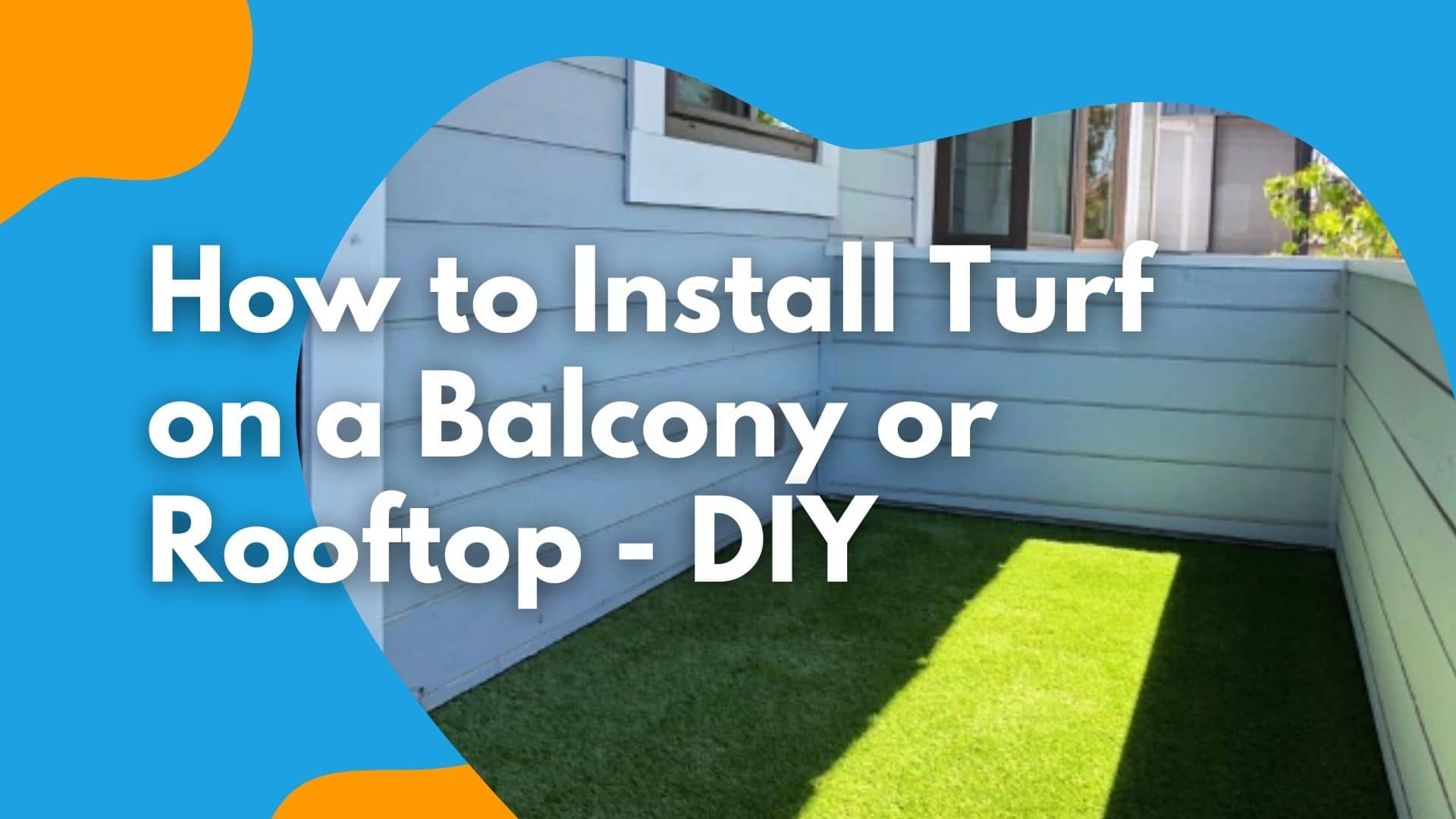
Looking to add some greenery to an otherwise drab space? Artificial grass is an excellent addition to balconies, patios, and rooftops to give you a bare-foot-friendly...